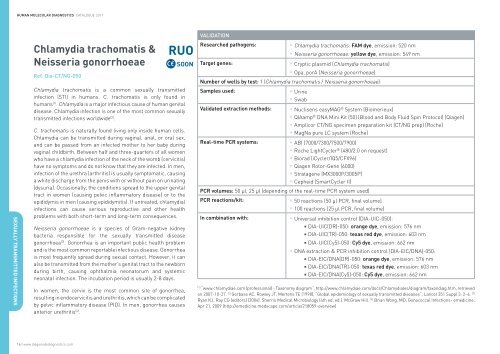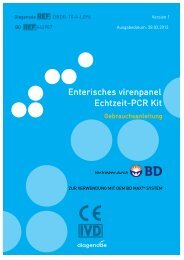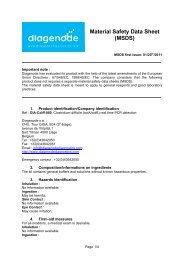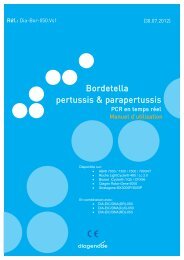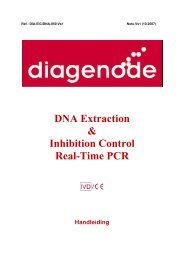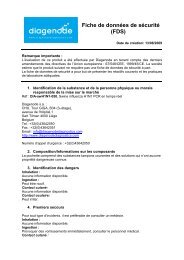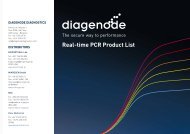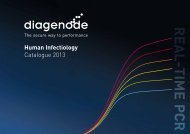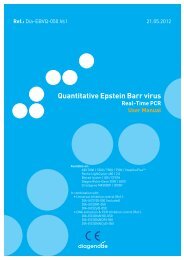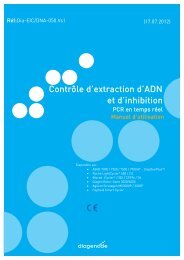Human Infectiology MDx | Catalogue 2011 - Diagenode Diagnostics
Human Infectiology MDx | Catalogue 2011 - Diagenode Diagnostics
Human Infectiology MDx | Catalogue 2011 - Diagenode Diagnostics
Create successful ePaper yourself
Turn your PDF publications into a flip-book with our unique Google optimized e-Paper software.
HUMAN MOLECULAR DIAGNOSTICS CATALOGUE <strong>2011</strong>SEXUALLY TRANSMITTED INFECTIONSChlamydia trachomatis &Neisseria gonorrhoeaeRef: Dia-CT/NG-050RUOSOONChlamydia trachomatis is a common sexually transmittedinfection (STI) in humans. C. trachomatis is only found inhumans (1) . Chlamydia is a major infectious cause of human genitaldisease. Chlamydia infection is one of the most common sexuallytransmitted infections worldwide (2) .C. trachomatis is naturally found living only inside human cells.Chlamydia can be transmitted during vaginal, anal, or oral sex,and can be passed from an infected mother to her baby duringvaginal childbirth. Between half and three-quarters of all womenwho have a chlamydia infection of the neck of the womb (cervicitis)have no symptoms and do not know that they are infected. In men,infection of the urethra (arthritis) is usually symptomatic, causinga white discharge from the penis with or without pain on urinating(dysuria). Occasionally, the conditions spread to the upper genitaltract in women (causing pelvic inflammatory disease) or to theepididymis in men (causing epididymitis). If untreated, chlamydialinfections can cause serious reproductive and other healthproblems with both short-term and long-term consequences.Neisseria gonorrhoeae is a species of Gram-negative kidneybacteria responsible for the sexually transmitted diseasegonorrhoea (3) . Gonorrhea is an important public health problemand is the most common reportable infectious disease. Gonorrheais most frequently spread during sexual contact. However, it canalso be transmitted from the mother’s genital tract to the newbornduring birth, causing ophthalmia neonatorum and systemicneonatal infection. The incubation period is usually 2-8 days.In women, the cervix is the most common site of gonorrhea,resulting in endocervicitis and urethritis, which can be complicatedby pelvic inflammatory disease (PID). In men, gonorrhea causesanterior urethritis (4) .VALIDATIONResearched pathogens:Target genes:• Chlamydia trachomatis: FAM dye, emission: 520 nm• Neisseria gonorrhoeae: yellow dye, emission: 549 nm• Cryptic plasmid (Chlamydia trachomatis)• Opa, porA (Neisseria gonorrhoeae)Number of wells by test: 1 (Chlamydia trachomatis / Neisseria gonorrhoeae)Samples used:• Urine• SwabValidated extraction methods: • Nuclisens easyMAG ® System (Biomerieux)• QIAamp ® DNA Mini Kit (50) (Blood and Body Fluid Spin Protocol) (Qiagen)• Amplicor CT/NG specimen preparation kit (CT/NG prep) (Roche)• MagNa pure LC system (Roche)Real-time PCR systems: • ABI (7000/7300/7500/7900)• Roche LightCycler ® (480/2.0 on request)• Biorad (iCycler/IQ5/CFX96)• Qiagen Rotor-Gene (6000)• Stratagene (MX3000P/3005P)• Cepheid (SmartCycler II)PCR volumes: 50 µl, 25 µl (depending of the real-time PCR system used)PCR reactions/kit:• 50 reactions (50 µl PCR, final volume)• 100 reactions (25 µl PCR, final volume)In combination with:• Universal inhibition control (DIA-UIC-050):DIA-UIC(DR)-050: orange dye, emission: 576 nmDIA-UIC(TR)-050: texas red dye, emission: 603 nmDIA-UIC(Cy5)-050: Cy5 dye, emission: 662 nm• DNA extraction & PCR inhibition control (DIA-EIC/DNA)-050:DIA-EIC/DNA(DR)-050: orange dye, emission: 576 nmDIA-EIC/DNA(TR)-050: texas red dye, emission: 603 nmDIA-EIC/DNA(Cy5)-050: Cy5 dye, emission: 662 nm(1)“www.chlamydiae.com (professional) - Taxonomy diagram”, http://www.chlamydiae.com/docs/Chlamydiales/diagram/taxondiag.htm, retrievedon 2007-10-27. (2) Gerbase AC, Rowley JT, Mertens TE (1998), “Global epidemiology of sexually transmitted diseases”, Lancet 351 Suppl 3: 2–4. (3)Ryan KJ, Ray CG (editors) (2004). Sherris Medical Microbiology (4th ed. ed.). McGraw Hill. (4) Brian Wong, MD, Gonococcal Infections- emedicine,Apr 21, 2009 (http://emedicine.medscape.com/article/218059-overview)16 | www.diagenodediagnostics.com


